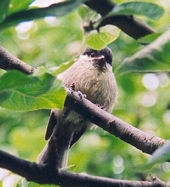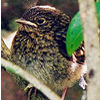For the last few winters I have fed the birds consistently (and probably
more carefully than I sometimes feed myself).
I've learned the importance of keeping up feeding once it has been started,
as the birds come to depend on it.
I have to admit that on those freezing winter mornings the prospect of
going outside - with a kettle of hot water to defrost the bird bath, and
with handfuls of food for the bird table - can seem mightily unappealing.
But again the garden and its wildlife illustrates another of those well-worn
truths - that you have to put something in to get something back. Birds
obviously won't hang about my garden on the off-chance I might feed them.
But now they've got used to being fed they're around all the time.
The regular supply of food has meant that over the few years we have been
here the birds have multiplied in the garden. The food is mainly bought
sunflower seed, nuts, porridge oats and fat balls, but the garden's apple
tree also feeds the birds, as they eat the windfalls on the ground and
also the apples left on the tree that we haven't been able to reach.
In the first few years, I stopped feeding during the warmer months. More recently I've found that the food seems to be needed most of the year, certainly by the sparrows. As sparrows' numbers are falling nationally, it seems important to look after the ones we have in this area, so I now carry on putting out the seed feeders.
Bird
feed and feeders from Amazon.co.uk
During the spring and summer months, alongside this bought-in food, there
is a pesticide-free supply of aphids and other garden pests. If I ever
needed further encouragement not to use noxious chemical sprays, it is
seeing the sparrows and blue tits swaying daintily from the new stems
of the climbing roses, picking off greenfly. I probably ingest more pesticides
than they do.

Above: young coal tit, summer 2002. Top left: young robin.

